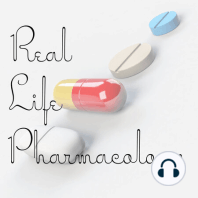12 min listen

Doxylamine Pharmacology
FromReal Life Pharmacology - Pharmacology Education for Health Care Professionals
Doxylamine Pharmacology
FromReal Life Pharmacology - Pharmacology Education for Health Care Professionals
ratings:
Length:
11 minutes
Released:
Jul 8, 2021
Format:
Podcast episode
Description
In the podcast this week, I talk about doxylamine pharmacology. Doxylamine is a first-generation antihistamine; it is commonly an active ingredient in night-time medications like Unisom, Nyquil, and Mucinex. The pharmacology of doxylamine is similar to other first-generation antihistamines, it competitively inhibits the binding of histamine at H1 receptors. Its main uses are as sleep aides, in cough-and-cold medications, but doxylamine has also been given with pyridoxine to treat nausea and vomiting during pregnancy.
Doxylamine’s adverse reactions are related to its anticholinergic properties, they include dry eyes, dry mouth, increased fall risk, sedation, urinary retention, constipation, and confusion. Contraindications include concurrent use with a monoamine oxidase inhibitor, known hypersensitivities, concomitant alcohol use, and if the patient has the following conditions: elevated intraocular pressure, narrow-angle glaucoma, asthma, peptic ulcer disease, urinary bladder neck obstruction, or gastric outlet obstruction. It is also a Beer’s list drug due to its anticholinergic effects. The normal dose in adults is 25 mg. In cases of overdosage, the most common manifestation is exacerbations of its anticholinergic effects. The major complications of an overdose include arrhythmia, respiratory failure, seizures, hyperthermia, rhabdomyolysis, and coma.
When you know a patient is taking doxylamine, it’s important to be cognizant of their occupation, as well as what other conditions they may have. For example, doxylamine should be used with caution in patients that drive heavy machinery due to its sedating properties. You might be able to tell if a patient’s experiencing an adverse reaction exacerbation if they begin having worsening dementia symptoms or increased urinary retention. Other indications include the use of artificial tears, or saliva, or increased complaints of constipation. To monitor for doxylamine, it’s important to monitor the patient’s tolerability. The onset of doxylamine is relatively quick as well, with a peak concentration within 2-4 hours.
For drug-drug interactions, CYP interactions aren’t as concerning as usual. The main interaction to consider when a patient is taking doxylamine is additive anticholinergic effects. Sedative effects can increase when benzodiazepines, skeletal muscle relaxants, opioids, or antihistamines are concurrently taken. Doxylamine can also counteract the usefulness of dementia or BPH medications due to its anticholinergic properties. There is also a risk of increased anticholinergic burden when taken with skeletal muscle relaxants or tricyclic antidepressants.
Show notes provided by Chong Yol G Kim, PharmD Student.
Doxylamine’s adverse reactions are related to its anticholinergic properties, they include dry eyes, dry mouth, increased fall risk, sedation, urinary retention, constipation, and confusion. Contraindications include concurrent use with a monoamine oxidase inhibitor, known hypersensitivities, concomitant alcohol use, and if the patient has the following conditions: elevated intraocular pressure, narrow-angle glaucoma, asthma, peptic ulcer disease, urinary bladder neck obstruction, or gastric outlet obstruction. It is also a Beer’s list drug due to its anticholinergic effects. The normal dose in adults is 25 mg. In cases of overdosage, the most common manifestation is exacerbations of its anticholinergic effects. The major complications of an overdose include arrhythmia, respiratory failure, seizures, hyperthermia, rhabdomyolysis, and coma.
When you know a patient is taking doxylamine, it’s important to be cognizant of their occupation, as well as what other conditions they may have. For example, doxylamine should be used with caution in patients that drive heavy machinery due to its sedating properties. You might be able to tell if a patient’s experiencing an adverse reaction exacerbation if they begin having worsening dementia symptoms or increased urinary retention. Other indications include the use of artificial tears, or saliva, or increased complaints of constipation. To monitor for doxylamine, it’s important to monitor the patient’s tolerability. The onset of doxylamine is relatively quick as well, with a peak concentration within 2-4 hours.
For drug-drug interactions, CYP interactions aren’t as concerning as usual. The main interaction to consider when a patient is taking doxylamine is additive anticholinergic effects. Sedative effects can increase when benzodiazepines, skeletal muscle relaxants, opioids, or antihistamines are concurrently taken. Doxylamine can also counteract the usefulness of dementia or BPH medications due to its anticholinergic properties. There is also a risk of increased anticholinergic burden when taken with skeletal muscle relaxants or tricyclic antidepressants.
Show notes provided by Chong Yol G Kim, PharmD Student.
Released:
Jul 8, 2021
Format:
Podcast episode
Titles in the series (100)
Urinary Anticholinergics RLP Episode 25: In this episode I discuss urinary anticholinergics and their effects. I cover mechanism of action, side effects, clinical practice pearls, and of course some drug interactions to look out for. Enjoy the episode and be sure to check out our free 31 pa... by Real Life Pharmacology - Pharmacology Education for Health Care Professionals